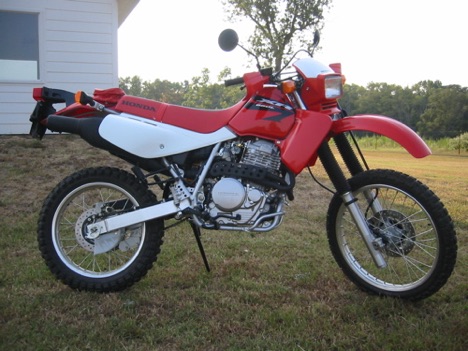August/September of 2005

Well, I think we've officially gone off the deep end. At least that's what most people say, after we describe what we're planning to do.
Several weeks ago, right after we started back to school, I got the regular Texas Cross Country Racing Association newsletter in the mail. In the back section there is always a place with web addresses relating to motorcycles in some way. The address www.transamtrail.com was in the newsletter.
The webpage described the ins and outs of the Trans-America trail.
In short, the trail is a 4200 mile route from Columbia, Tennessee to Port Oreford, Oregon. This "trail" follows existing roads, but less than 100 miles is on pavement, with parts consisting of trails only passable by motorcycles, more precisely, dual-sport motorcycles. (A dual sport motorcycle is a motorcycle that's legal to drive on public roads, but is just as comfortable on a tight, twisty, forest trail that's only a foot or two wide.)
A fellow by the name of Sam Correro, a pharmacist from Mississippi, has created the trail in his spare time, spending hours upon hours looking and studying maps and piecing together a nearly all off-pavement route. As he's done this, he's created maps for the entire route, along with Roll-Chart directions.
Roll Charts are an interesting invention. Initially used for motorcycle enduro competitions, showing competitors the correct direction, they have been adapted for purposes of general travel like this. Fairly simple in concept, directions are printed on a roll of paper about the same width as a receipt from a store, except the receipt takes a full roll of paper. The roll of paper is inserted into an aptly named Roll-Chart holder.
The holder is mounted on the handlebars of a motorcycle. Directions are printed on the paper from bottom to top. So, as you ride along, you read the directions. As the directions go from bottom to top, a turn of the top knob will scroll up the roll. Therefore, you are able to ride and read directions at the same time. If there are many turns, directions go by fairly quickly and much knog turning ensues. On the other hand, a fewer number of turns means not many directions very little knobular action.
Needless to say, in 4200 miles, consisting of mainly dirt roads, there will be many turns. Sam prints directions from his computer. From the printer, directions come in three columns per page. He cuts each page into thirds and tapes them together, creating a roll of directions.
He also has created maps consisting of a section of each state the trail passes through. Many companies make waterproof map cases designed for mounting on the motorcycle in a place where they are easily viewed while riding. Most cases are designed to be mounted to the handlebars, making map and Roll-Chart reading just a glance away while you're riding down the road.
Through email, Sam has said that the combined weight of the maps is approximately 5 pounds. He sells sets of maps in just about any combination. The cost of maps for the entire route is $288. But each state can be purchased seperately, with the cost depending on the size of the state.
Maps are Sam's job. The rest of preperation is solely on the shoulders of the traveler. Which is where we are now.
To be honest, I'm a little overwhelmed.
First off, before we thought about doing this, Meredith had never ridden a full size bike(which is necessary for that length of a trip) on or off road. And coupled with the fact that she had never ridden a motorcycle on pavement before, the question of her ability loomed. We've had a Suzuki DR 350 ES since I was in college, but I was always the one riding on the road. Until a few weeks ago, I never gave any thought to her ability of riding it.
As soon as we thought about

doing it, she immediately jumped on it. It fit her perfectly. We've been riding almost every day since and she's very comfortable now.
Fortunately, or unfortunately, depending on you look at it, that left me bike-less. So my search for a bike began. Dual-Sport bikes are fairly common, but not many different models are made. My choices were the Suzuki DR-Z 400, the Suzuki DR 650S, the Honda XR 650L, or the Kawasaki KLR 650.
I wanted a larger bike than a 350 cc because Meredith's bike will run 70 mph, but not comfortably, and I figured we'd want a bike that can move down the highway, if needed. Also, I'll probably be carrying more

weight. Therefore, a larger bike was in order. Since the DR-Z 400 wasn't hardly any bigger, I ruled it out immediately. The DR 650S was plenty large engine-wise, but is more street oriented than dirt. So, it had to go. Same reason for the Kawasaki. The Honda was the winner of my impromtu Dual-Sport contest.
The XR 650L is an air-cooled, 649 cc, single-cylinder four stroke. Designed in the mid-1980's as a off-highway only bike, Honda has, over the years, given it a set of blinkers and mirrors, satisfying the requirements for on-highway travel, yet retaining all of its dirt skills.
So, I purchased a brand-spankin new 2006 Honda XR 650L a week ago.
To tell the truth, its an amazing bike. Fairly tall, with a 37 inch seat height, and fairly heavy, at 324 pounds, the bike is very smooth on or off road, and it has tons of power. I have a feeling it will be exactly what I need.
